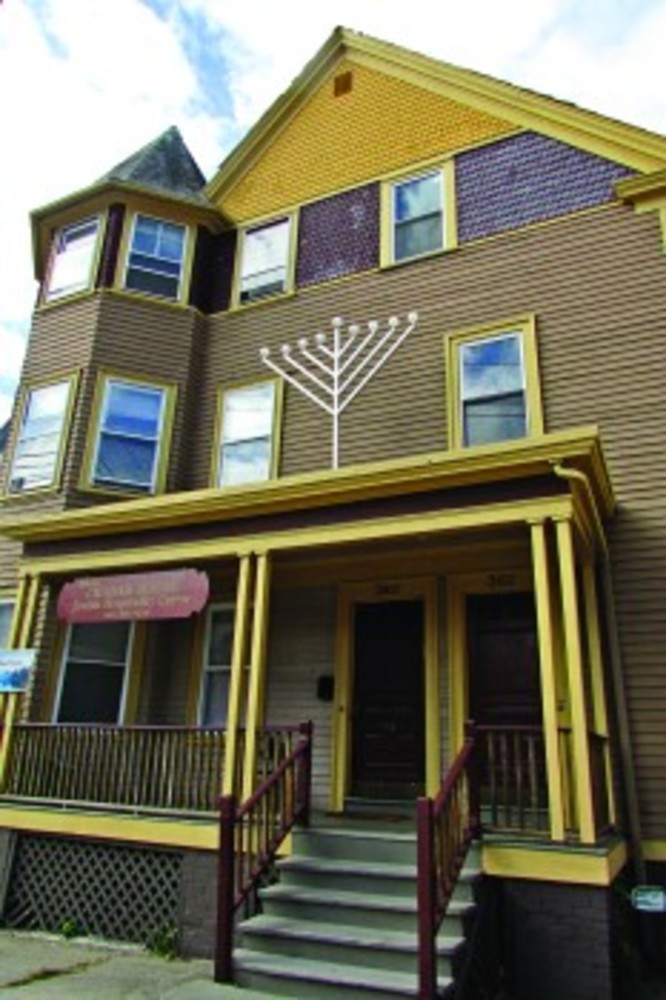Two sanctuaries: Spiritual neighbors on the East Side
 Chabad House on Hope Street.
Chabad House on Hope Street.
It may sound ridiculous: comparing two sanctuaries, especially when they represent different religious and architectural traditions. The point, however, is not to affirm the superiority of one over the other. Rather, the juxtaposition is intended to be mutually beneficial, showing, perhaps, how one sanctuary illuminates its sister.
Chabad House on Hope Street and the Society of Friends Meetinghouse on Olney Street are only a few blocks apart but, within the glow of Roger Williams’ heritage, are spiritual neighbors. Both buildings, which serve tiny congregations, are small and unobtrusive. Neither is adorned with such symbols as spires, domes, bell towers or colored windows.
Chabad is literally a house, for it was built around 1920 as a three-decker apartment. It is also a house in the sense that, upstairs, it is the successor to Providence’s Hebrew Sheltering Society. Much newer, the Friends Meetinghouse was built on the Moses Brown campus in 1954, after its previous home, on North Main Street, was demolished for the construction of a firehouse. Like Chabad, the new meetinghouse also houses other facilities: a kitchen and “multipurpose” rooms. The new meetinghouse, the same age as Temple Beth-El, is fortunate to be surrounded by greenery, some open spaces and the occasional sounds of children.
Some might say that Chabad House is an architectural oddity or orphan; its congregants could daven anywhere. Providence’s Chabad, part of a global network, is connected in many ways to its parent sanctuary at 770 Eastern Parkway in Brooklyn, and to the Rebbe’s nearby resting place. Both these pilgrimage sites are further accessible through rabbis manning telephones and the latest high-tech media. Some Chabad houses are so closely connected to 770 that they replicate this architecturally unremarkable building.
The Friends Meetinghouse, designed by Albert Harkness and built in a generic Georgian revival style, is part of the New England Yearly Meeting. Its parent sanctuary is Newport’s Friends Meetinghouse, which was begun in 1699 and remains Rhode Island’s oldest extant house of worship. (The Newport Historical Society has maintained this enormous wooden structure as a museum since the 1970s.) Of course Jews and Friends, fellow outcasts from more desirable places, were neighbors and business rivals in colonial Newport. Forbidden use of Newport’s Common Burial Ground, laid out in 1665, they consecrated their own cemeteries.
Providence’s Chabad House and Friends Meetinghouse descend from the same religious and architectural principle, essentially the Third Commandment, which forbids the making of graven images. Some historians would explain that both religions exemplify an iconoclastic tradition, which, in its severity, deprives worshippers of visual instruction and pleasure. Other observers would readily argue, however, that such an absence of representational imagery, while denying idolatry, actually empowers reflection and prayer.
In terms of congregational dynamics, the Chabad and Friends sanctuaries are probably not farther apart. While Judaism encourages scattered moments of silence, Friends gather in silence and arise to speak only when they are so moved. Although Jewish worship does not require rabbinic or cantorial leadership, Friends function without clergy (or a panoply of local, self-help organizations).
There are of course many other obvious religious and architectural differences between the Chabad and Friends sanctuaries. For instance, Chabad faces east toward Jerusalem, though congregants turn westward when they welcome the Sabbath bride. Typically, when Orthodox readers and worshippers face the aron kodesh (ark), they display their backs to one another. Of course within Orthodox tradition, men and women are seated separately. By contrast, all Friends are integrated within their pews. Without the need to read or sing aloud from a holy text or prayer books, Friends face one another.
Although the Friends Meetinghouse is free of ornamentation and liturgical objects, Chabad House offers many visual references (and more than a little clutter). In addition to such obvious objects as a handsomely shaped aron kodesh, an embellished parochet (curtain), and ornate rimonim (Torah finials), there are a ner tamid (eternal light), candlesticks, kiddush cups, and mezzuzot as well as kippot and tallit. Chabad’s plethora of books, donors’ plaques, pushkes, and portraits of the Rebbe offer further visual enrichment.
In contrast to the meetinghouse’s bare brick exterior, Chabad’s unexpected presence, opposite a pizza parlor and a Mexican restaurant, is confirmed by a large, metal hanukkiyah. Indeed, for the sake of summoning a Minyan, Rabbi Yehoshua Laufer is known to stand on the sidewalk and ask passersby (men only) if they are Jews. If so, they are commanded to help.
Chabad House and the Friends Meetinghouse are united by their reverence for light. At Chabad, light, which is revealed through rows of windows along its eastern and southern walls, signals Shabbat’s beginning and end as well as the passage of other holy days. Indeed, light, one of the Lord’s first creations, symbolizes holiness and enlightenment. The sanctuary of the Friends Meetinghouse is surrounded on three walls by high, curtainless windows. Friends are also guided and warmed by an unflickering inner light.
In my opinion, neither of the East Side sanctuaries can be considered austere or sanctimonious. Rather, each is magnificent in its reticence and yearning. Embodying peace and goodness, both sanctuaries are springboards for improving ourselves and our world.
GEORGE GOODWIN, a member of Temple Beth-El, has edited the “Rhode Island Jewish Historical Notes” for 10 years.







